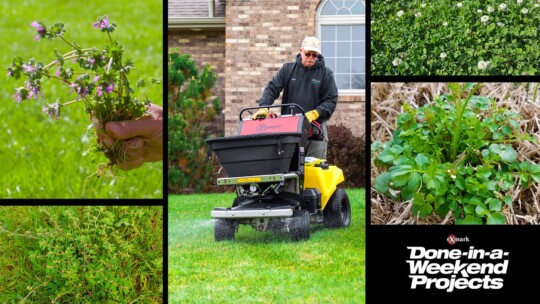A sick lawn is an unhappy lawn, and it’s bound to tank your yard’s curb appeal. That’s where knowing the warning signs and symptoms of lawn disease comes into play. All it takes is an eagle eye—and a quick walk around your lawn—to nip most in the bud. So, follow along to learn the common signs of sickness, and the ways to prevent them, to get ahead of the spread.
Common Warm-Season Lawn Diseases
- Large patch: A disease that latches on to warm-season grasses, large patch lives up to its name. It manifests in circular, discolored patches with an orange or yellow ring that measure from one to three feet in diameter. Another way to detect large patch is to pull on the affected grass. If the shoots pull up easily, it’s infected.
- Leaf spot: A warm-season grass disease, leaf spot first shows up in dark purple or black spots. They eventually grow to have a tan center and surrounding yellow halo.
- Pythium blight: Another disease that impacts warm-season grasses, Pythium blight manifests itself through brown, grease-colored spots that measure about two centimeters to two inches in diameter. If left untreated, they can grow cotton candy-like fungus that help spread the disease even further.
- Red thread: Early signs of red thread include circular- or oval-shaped patches on warm-season grasses that measure about two inches to three feet in diameter. These patches have a reddish-pink hue and usually start at the tip of the blade.
- Rust: In warm-season grasses, rust begins as tiny yellow spots that grow out into larger orange, red and brown circles. If touched, powdery, dust-like spores leap from the affected blade.
- Summer patch: Also known as necrotic ring spot, summer patch appears in warm-season grasses. It’s characterized by dark-green or straw colored patches that usually measure up to two inches in diameter.
Common Cool-Season Lawn Diseases
- Brown patch: Usually attacks cool-season grasses and appears in the form of sunken, circular patches of tan, or dead, grass that can measure up to three feet in diameter.
- Pink snow mold: Aptly named because it appears after snow melts, pink snow mold appears in cold-season grasses through pink, white, or tan patches of dead grass that are ringed by copper-colored blades.
- Fairy ring: While it has a fantastical name, fairy ring is anything but. Mainly impacting cold-season grasses, this disease appears through brown or dark green circular patches that grow into mushrooms or puffballs, like Pythium blight
Lawn Disease for Both Grass Types
- Dollar spot: This disease affects both warm- and cool-season grasses. It gets its name because the infected area’s the size of a silver dollar (or, two to six inches in diameter). The blades of grass infected by dollar spot look water-soaked and contain yellow spots ringed with a reddish-brown coloring.
- Gray leaf: Like dollar spot, this disease impacts warm- and cool-season grasses alike. It’s noticeable by tiny lesions on individual blades that spread into spots that eventually encompass the entire blade. These spots range in color from tan to (mainly) gray and have tinier purple dots in them.
Lawn Disease Causes
- Poor Watering Habits: Watering too much, or too little, can lead to lawn disease. If you’re watering every day, scale it back a bit. Conversely, if you’re watering only once a month, up that number. However, cool-season grasses require more watering than warm-season grasses. So it might deem necessary to add one additional watering session per week if you start to see symptoms.
- Wrong Mowing Height: Different grasses have different ideal mowing heights, and cutting the grass too short can lead to the sun’s heat damaging the grass and exposing the roots/soil to too much sunlight, opening a door for disease to take root. Before you take your Exmark mower out for your next mowing session, it’s best to do the proper research on the type of grass in your yard and learn its ideal height.
- Overly Thick Thatch: Thatch is the layer of organic matter (such as twigs, leaves, and other lawn debris) that accumulates at the base of grass. It’s best to plan a regular dethatching, but the frequency depends on what type of grass you have, so do your research beforehand.
- Compacted Soil: We all like to enjoy our backyard, but frequently walking across certain sections causes soil compaction. This is where aeration comes into play, warding off potential disease by allowing your lawn’s roots to expand.
- High Soil pH Levels: If the soil in your lawn is too acidic, it makes your grass more susceptible to contracting disease. Over-fertilizing is bound to make your soil’s pH levels skyrocket. Powdered or pelleted limestone is a good way to counter high acidity, but be careful—it’s much easier to raise pH than to lower it. To get ahead of the game, it’s always best to schedule a routine soil pH level testing through your local Department of Natural Resources.
Make sure to remember these symptoms, and their common causes, the next time you’re getting ready to mow… Your grass will thank you later.
Find the answers to the lawn-and-garden questions homeowners are looking for: Watch Backyard Smart



